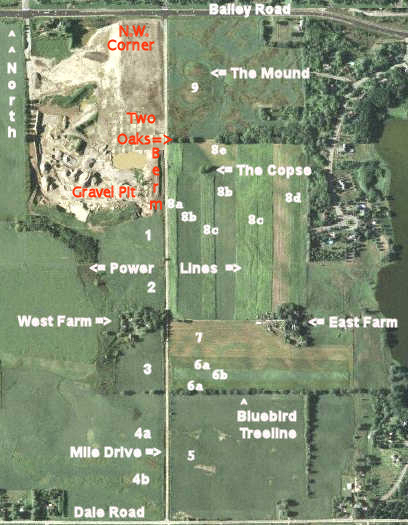
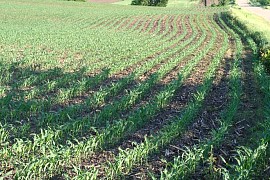 The corn in Field #9 is growing rapidly - we have had rain and hot temperatures.
In North America, fields are often planted in a two-crop rotation with a nitrogen-fixing crop,
often alfalfa in cooler climates and soybeans in regions with longer summers. This replentishes
nitrogen and helps keep corn rootworm from taking hold.
The corn in Field #9 is growing rapidly - we have had rain and hot temperatures.
In North America, fields are often planted in a two-crop rotation with a nitrogen-fixing crop,
often alfalfa in cooler climates and soybeans in regions with longer summers. This replentishes
nitrogen and helps keep corn rootworm from taking hold.
|
 Just some individual plants from the scene above.
Just some individual plants from the scene above.
|
|
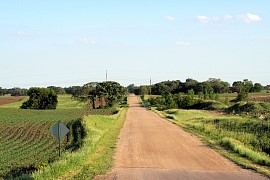

The fast flying birds swooping along the road catching bugs are barn swallows
The barn swallow, (Hirundo rustica), is found throughout much of the world and is resident on
all the continents except Australia. It is easily distinguished from other American swallows
by it's deeply forked tail and rust colored underparts. The barn swallow's aerial maneuvering
is unexcelled. It can effortlessly make sharp turns while flying at high speed, enabling it
to catch flies and other insects on the wing and in great numbers. Barn
swallows usually nest in small colonies and also hunt together. Most of their hunting is done near ground level,
over open fields and especially near water. However, often, on late summer afternoons,
they can be seen hunting high in the air. They simply follow the insects, which, in turn,
may be reacting to differences in air temperature.
Swallows will take advantage of any human activity that stirs up insects, whether it is a single
person walking through tall grass or a huge noisy machine harvesting wheat.
All sorts of outbuildings are used by barn swallows for nesting, from small sheds to the hayloft of
huge barns.
The one requirement is that they have access, usually through an open door or window.
Swallows prefer unpainted rough cut wood on which to build their mud nests, since the mud will not
adhere well to smooth surfaces
|
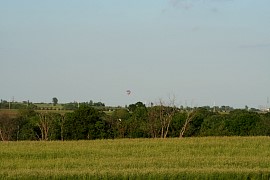
A far-away shot of a hot air balloon. A company in a nearby city gives balloon rides - support
trucks on the ground follow and pay whichever farmer owns the land the ballon ulitmately lands on.
Maybe later this summer I'll get a better shot of a nearer balloon.
|
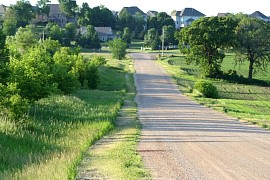
Early summer along the road. On the left is the soon-to-be destroyed berm. You can
get an idea by the size of the trees how long it had been in existance.
|
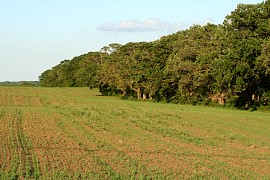
The corn along the north side of Bluebird Treeline is sprouting.
|
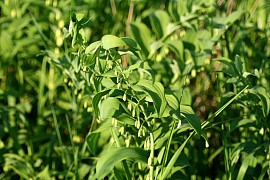
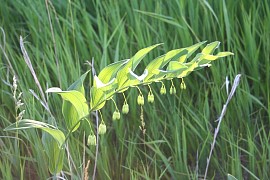
Solomon's Seal (Polygonatum biflorum) whitish-greenish bell-shaped flowers dangle along the stem
under the leaves; it will produce red berries. The young shoots have been eaten much like asparagus.
The name Solomon's Seal is attributed to the appearance of the cross section of the stem where it
attaches to the underground root structure called the rhizome.
In the winter when the aboveground stem dies back, a cicatrix or scar is formed on the
rhizome.
The shape of the cicatrix is said to resemble the seals that were once used to seal letters with wax.
The scar calls to mind the Seal of Solomon, which may be either the hexagram symbol of Israel now
known as the Star of David, or to the five-pointed pentagram star that was also an early symbol of
mysticism. Return to Flora
|
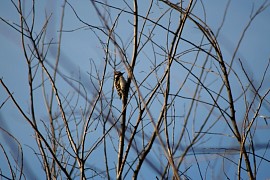
Downy Woodpecker (Picoides pubescens).
This woodpecker is black and white with a broad white stripe down the back from the shoulders
to the rump. Its wings are checkered in a black and white pattern that shows through on the wings’
undersides, and the breast and flanks are white. The crown of the head is black; the cheeks and neck
are adorned with black and white lines. Male and female Downy Woodpeckers are about the same size,
weighing from 21 to 28 g. The male has a small scarlet patch, like a red pompom, at the back of
the crown. The Downy’s name refers to the soft white feathers of the white strip on the lower back,
which differ from the more hairlike feathers on the Hairy Woodpecker.
|
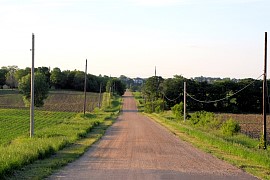

As the light of day starts to fade the moon makes it's appearance.
|
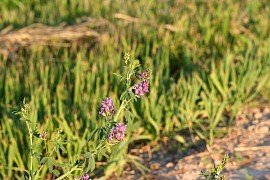
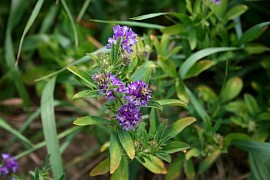
Alfalfa (Medicago sativa), a member of the pea family, is one of the most important forages
(feed) for livestock. It is
referred to as "Queen of Forages". It is the most important "high quality"
forage crop because of its high protein, vitamins, energy, digestibility.
It was first originated in Asia before 700 BC. It was thought to have been cultivated first in Iran.
The Arabs gave Alfalfa its name which means 'father of all foods' and fed it to their horses to
make them run faster. Return to Flora
|
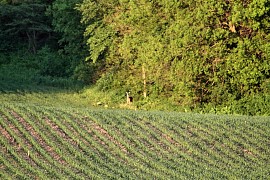
This isn't great photography - down below Two Oaks a Whiteie-tailed deer (Odocoileus virginianus)
cautiously looks out from the edge of the woods. White-tail deer have good eyesight and acute hearing,
but depend mainly on their sense of smell to detect danger. White-tail deer wave their tails
characteristically from side to side when they are startled.
White-tailed Deer" refers to the white underside of the tail, which is held conspicuously erect like
a flag when the animal is alarmed or running. The adult White-tailed Deer has a bright, reddish brown
summer coat and a duller grayish brown winter coat. White fur is located in a band behind the nose,
in circles around the eyes, inside the ears, over the chin and throat, on the upper insides of the
legs and beneath the tail. The young, called fawns, have reddish coats with white spots.
|